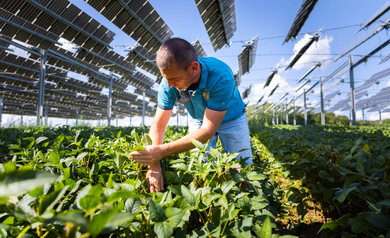Tower Companies Transform Cellular Services in Latin America and the Caribbean

Providing cellular coverage and other wireless services in remote areas is feasible when infrastructure is shared. Two projects approved by IDB Invest are proof of this: Red Compartida (Shared Network) in Mexico, and Internet para Todos (Internet for Everyone) in Peru. Even in areas that already enjoy coverage, the growing demand for mobile data has created the need to increasingly expand network capacity, which requires adding more sites within the same geographical area. This densification is important to support the gigantic and exponential flow of digital data. As such, tower companies play a pivotal role in optimizing efficiency.
Why should a company tie up millions of dollars in passive network components such as cell towers when it can outsource its infrastructure to specialized players? Cisco estimates that in Latin America and the Caribbean (LAC), mobile data traffic will grow at an annual rate of 43 percent between 2017 and 2022. This puts enormous pressure on governments, which are forced to bid for additional electromagnetic spectrum, and on mobile network operators (MNOs), which are pushed to invest to meet this growing demand.
In response, MNOs have massively embraced the shared infrastructure model. Tower companies house antennas for several MNOs in a single tower, thus generating significant operational and capital savings. This also frees up resources for MNOs to wage battle where it really counts: in their relationship with end users of the Internet, an area where, to date, wholly digital companies—such as technology giants—have captured the lion's share of value.
The love and hatred of towers
When one thinks of towers that inspire admiration and all manner of obsessions, the list is short and clear: the Tower of Babel, the Tower of Pisa, and the Eiffel Tower. Society has always been obsessed with towers, and the loftier, stronger and more striking, the better. Modern society has created utility towers to bring people the telegraph, the telephone, and electricity, yet our relationship with cell towers has turned out to be strikingly ambiguous: we sorely need them, but nobody wants to be near one.
To date, there are almost 4.7 million of these towers worldwide, of which more than 180,000 are in LAC.
Cell towers vary in height, location, and purpose; some are on dedicated sites, others on rooftops. From an urban point of view, they are often considered an aesthetic nuisance. Other times, they are cleverly disguised as palm trees or in fake water tanks. What they all have in common, however, is that they support powerful telecommunications equipment. Given that the most common means of accessing the Internet is via mobile devices, cell towers are undoubtedly a key asset of the most important type of infrastructure of the 21st century: digital infrastructure.
Tower companies and outsourcing
In LAC, cell tower outsourcing has been around for a decade. What is striking is that more than 52 percent of all telecommunications towers in the region are already owned by independent tower companies, which include strategic players such as American Towers and SBA, along with a host of other companies supported by the world's leading investment funds: Grupo Torresur (Providence Partners), ATP (Colony Capital), PTI (Blackstone), BTST (Cartesian), and others. These tower companies have established their business by purchasing existing tower portfolios from MNOs or by commissioning new towers and then making them profitable through efficient operation and a strong focus on the sale of excess capacity.
Bolivia, one of the last countries in the region lacking such activity, made its debut in 2019 with the entry of PTI, which bought a portfolio of more than 600 towers through IDB Invest financing for $60 million, mobilized by CIFI. In just 10 years, tower companies in LAC have become key players in bridging the digital divide. What began as a business model based on real estate outsourcing is now rapidly consolidating and becoming increasingly sophisticated.
Tower companies are expanding their value-added services offering to include energy management, the sale of fiber optic capacity, and the construction of other types of infrastructure. This includes the deployment of networks for the Internet of Things, distributed antenna systems (which allow us to be online in subways, stadiums, and convention halls), or edge computing, which brings data storage closer to major consumption points.
The exponential leap, however, is expected to occur in the near future via 5G. The next generation of mobile technology, which will proliferate use cases such as autonomous cars, will require an enormous densification of existing networks. This translates into thousands upon thousands of new sites to support what many believe will be the largest infrastructure investment program in history. This will require tower companies, governments, cities, and MNOs to work together to ensure efficient deployment.
In short, for as long as our obsession with being permanently connected to our smartphones in even the remotest of regions persists, or if our cars are to be ready to self-drive on the streets of our cities, we must continue to support shared infrastructure and innovation in these business models. This means that tower companies will have to offer a more holistic range of services, including—let's face it—towers camouflaged as light poles, traffic lights, or perhaps even cacti.■
LIKE WHAT YOU JUST READ?
Subscribe to our mailing list to stay informed on the latest IDB Invest news, blog posts, upcoming events, and to learn more about specific areas of interest.
Subscribe


